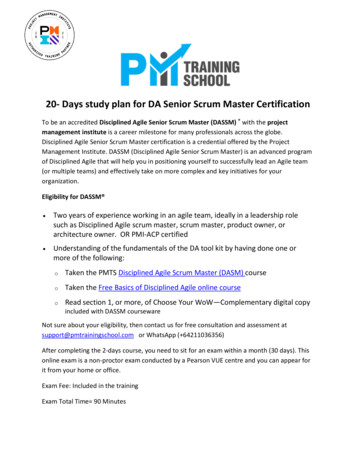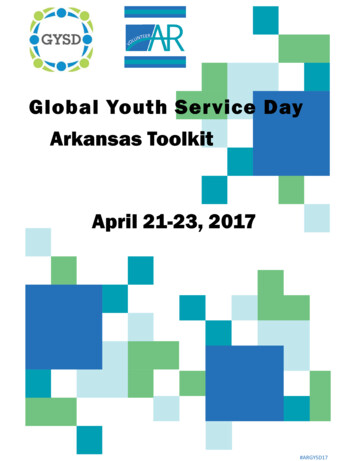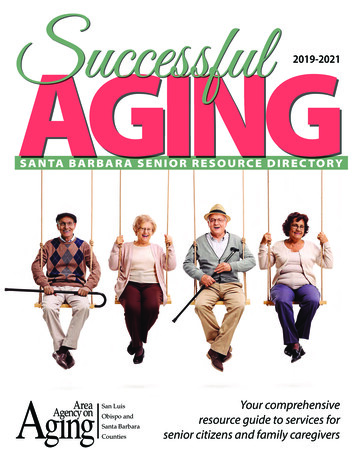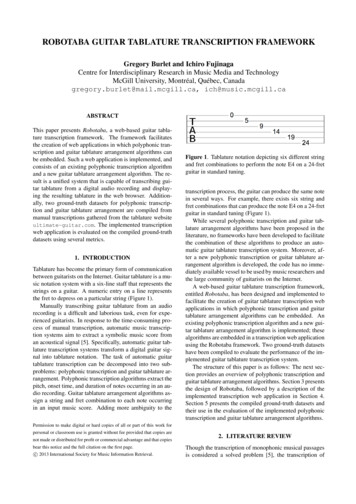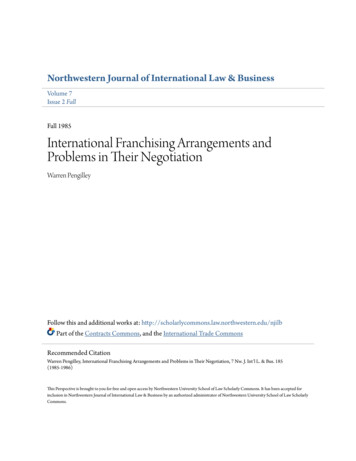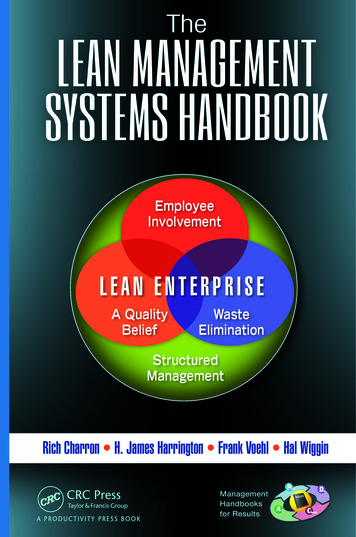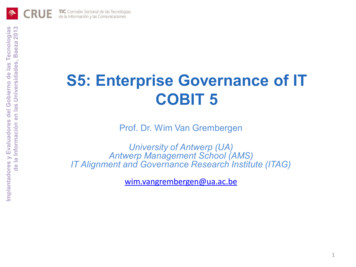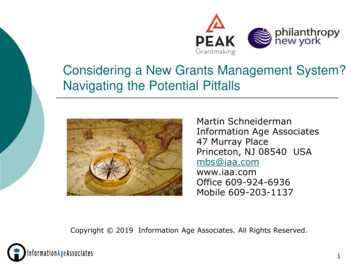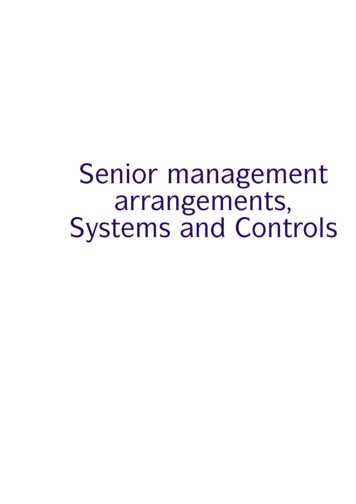
Transcription
Senior managementarrangements,Systems and Controls
SYSC ContentsSenior management arrangements, Systems and ControlsSYSC 11.1A1.21.41.51 Annex 1SYSC 22.12.2SYSC 33.13.23.33.4SYSC 44.14.24.34.3A4.44.54.64.74.84.94 Annex 1SYSC 55.15.25 Annex 1SYSC–iApplication and purposeApplicationPurposeApplication of SYSC 11 to 28Significant SYSC firmDetailed application of SYSCSenior management arrangementsApportionment of ResponsibilitiesRecording the apportionmentSystems and controlsSystems and controlsAreas covered by systems and controlsAdditional requirements for insurance distributionSRD requirementsGeneral organisational requirementsGeneral requirementsPersons who effectively direct the businessResponsibility of senior personnelManagement body and nomination committeeApportionment of responsibilitiesEmployees, agents and other relevant personsSkills, knowledge and expertise[deleted]www.handbook.fca.org.uk Release 17 Mar 2022
SYSC ContentsSYSC 6Compliance, internal audit and financial crime6.16.26.3ComplianceInternal auditFinancial crimeSYSC 7Risk control7.1Risk controlSYSC 8Outsourcing8.1General outsourcing requirementsSYSC 9Record-keeping9.19.2General rules on record-keepingCredit institutions providing account information services or paymentinitiation servicesSYSC 10Conflicts of interest10.110.1A10.2ApplicationIDD Regulation – Conflicts of interestChinese wallsSYSC 10A10A.1SYSC 1111.1SYSC 1212.1SYSC 1313.113.2 Release 17Recording telephone conversations and electronic communicationsApplicationLiquidity risk systems and controlsApplicationGroup risk systems and controls requirementsApplicationOperational risk: systems and controls for insurersApplicationPurpose Mar 2022www.handbook.fca.org.ukSYSC–ii
SYSC Contents13.313.413.513.613.713.813.913.10SYSC 1414.1Other related Handbook sectionsRequirements to notify the appropriate regulatorRisk management termsPeopleProcesses and systemsExternal events and other changesOutsourcingInsuranceRisk management and associated systems and controls forinsurersApplicationSYSC 15Credit risk management systems and controls for insurersSYSC 16Market risk management systems and controls for insurersSYSC 17Insurance risk systems and controlsSYSC 18Whistleblowing18.118.318.418.518.6Application and purposeInternal arrangementsThe whistleblowers’ championSettlement agreements with workersWhistleblowing obligations under the MiFID regime and other sectorallegislationSYSC 19AIFPRU Remuneration Code [deleted]SYSC 19BAIFM Remuneration Code19B.1ApplicationSYSC 19CBIPRU Remuneration Code [deleted]SYSC 19DDual-regulated firms Remuneration Code19D.1SYSC–iiiApplication and purposewww.handbook.fca.org.uk Release 17 Mar 2022
SYSC Contents19D.2General requirement19D.3Remuneration principles19D Annex 1 Detailed provisions on voiding and recovery (SYSC 19D.3.66R and SYSC19D.3.67R)SYSC 19E19E.119E.2UCITS Remuneration CodeApplicationRemuneration policies and practicesSYSC 19F19F.119F.2Remuneration and performance managementMiFID remuneration incentivesIDD remuneration incentivesSYSC 19G19G.119G.219G.319G.419G.519G.619G.719G Annex 1MIFIDPRU Remuneration CodeGeneral applicationRemuneration policies and practicesGovernance and oversightFixed and variable components of remunerationApplication of remuneration requirements to material risk takersVariable remunerationRemuneration committeeOther instruments for use in variable remunerationSYSC 20Reverse stress testing [deleted]SYSC 21Risk control: additional guidance21.1Risk control: guidance on governance arrangementsSYSC 22Regulatory 922 Annex 1 Release 17ApplicationGetting, giving and updating references: the main rulesDrafting the reference and the request for a referenceDrafting the reference: detailed requirementsGiving references: additional rules and guidance for all firmsGiving and updating references: additional rules and guidanceGetting references: additional rules and guidance for SMCR firmsPolicies and appointed representativesGroups and outsourcingRecords and transitionalsTemplate for regulatory references given by SMCR firms and disclosurerequirements Mar 2022www.handbook.fca.org.ukSYSC–iv
SYSC Contents22 Annex 2SYSC 2323.123.223.323.423 Annex 123 Annex 2SYSC 2424.124.224.324 Annex 1SYSC 2525.125.225.325.425.525.625.725.825.925 Annex 1SYSC 2626.126.226.326.426.526.6SYSC–vFactors to take into account when asking for and giving regulatoryreferencesSenior managers and certification regime: Introduction andclassificationPurposeDefinitions and types of firmsOverview of the senior managers and certification regimeCriminal record checks for certain directorsDefinition of SMCR firm and different types of SMCR firmsForm O: Changing firm status under the Senior Managers andCertification RegimeSenior managers and certification regime: Allocation of prescribedresponsibilitiesApplicationAllocation of FCA-prescribed senior management responsibilities: Mainallocation rulesWho prescribed responsibilities should be allocated toWhich FCA-prescribed senior management responsibilities apply to whichkind of firmSenior managers and certification regime: Managementresponsibilities maps and handover procedures and materialApplication and purposeManagement responsibilities maps: Main rulesManagement responsibilities maps: Exclusion of non-financial servicesactivities for some firmsGuidance about what should be in a management responsibilities mapManagement responsibilities map should be a single documentManagement responsibilities maps: Material only relevant to EEA SMCRfirmsGuidance about SYSC 25 Annex 1GManagement responsibilities maps: RecordsHandover procedures and materialExamples of the business activities and functions of an SMCR firmSenior managers and certification regime: Overall and localresponsibilityApplicationPurposeMain rulesExclusionsGuidance on territorial scopeMeaning of local and overall responsibility: Generalwww.handbook.fca.org.uk Release 17 Mar 2022
SYSC Contents26.7Meaning of local and overall responsibility: Reporting to the governingbodyMeaning of local and overall responsibility: Not reporting to thegoverning bodyWho functions should be allocated toGroup management arrangements and outsourcingLink between this chapter and other parts of the senior managersregime26.826.926.1026.11SYSC 27Senior managers and certification regime: Certification regime27.127.227.327.427.527.627.727.827.927 Annex 1SYSC 2828.128.228.328.428.5Application and purposeRequirements of the certification regimeTerritorial scopeGeneral material about the scope of the certification regimeExclusions for emergency and temporary appointmentsOther exclusionsSpecification of functionsDefinitions of the FCA certification functionsMaterial relating to several FCA certification functionsExamples of how the temporary UK role rule in SYSC 27.5.3R (the 30day rule) worksInsurance distribution: specific knowledge, ability and good reputerequirementsMinimum knowledge, ability and good repute requirements for carryingout insurance distribution activitiesKnowledge and ability requirementsGood reputeRecord-keeping requirementsOther requirements to considerTransitional provisions and SchedulesTP 2TP 3TP 5TP 6TP 7TP 8TP 9TP 11Sch 1Sch 2Sch 3Sch 4Sch 5 Release 17Firms other than common platform firms, insurers, managing agents andthe SocietyRemuneration codesFinancial Services (Banking Reform) Act 2013: Certification andregulatory referencesTransitional Provision 6Bank of England and Financial Services Act 2016: Certification andregulatory referencesBank of England and Financial Services Act 2016: Application to claimsmanagement companiesUpdates to reflect CRD VMIFIDPRU Remuneration Code transitional provisionRecord keeping requirementsNotification requirementsFees and other required paymentsPowers exercisedRights of action for damages Mar 2022www.handbook.fca.org.ukSYSC–vi
SYSC ContentsSch 6SYSC–viiRules that can be waivedwww.handbook.fca.org.uk Release 17 Mar 2022
Senior management arrangements, Systems and ControlsChapter 1Application and purpose Release 17 Mar 2022www.handbook.fca.org.ukSYSC 1/1
SYSC 1 : Application andpurposeSection 1.1A : Application11.1A1.1A.1GApplicationThe application of this sourcebook is summarised at a high level in thefollowing table. The detailed application is cut back in SYSC 1 Annex 1 and inthe text of each chapter.Type of firmApplicable chaptersInsurer, UK ISPVChapters 2, 3, 12 to 18, 19F.2, 21, 22, 23, 24, 25,26, 27, 28Managing agentChapters 2, 3, 11, 12, 18, 19F.2, 21, 22, 23, 24,25, 26, 27, 28SocietyChapters 2, 3, 12, 18, 19F.2, 21, 22, 23, 24, 25,26, 27, 28Any other SMCR firmChapters 4 to 12, 18, 19D, 19F, 19G, 21, 22, 23,24, 25, 26, 27, 28Every other firmChapters 4 to 12, 18, 19D, 19F, 19G, 21, 22, 28Firms that SYSC 19D applies to should also refer to the Remuneration part ofthe PRA Rulebook.1.1A.1AGThe application of this sourcebook to specific firms that are not PRAauthorised persons is summarised at a high level in the following table. Thedetailed application is cut back in SYSC 1 Annex 1 and in the text of eachchapter.Type of firmApplicable chaptersFull-scope UK AIFMChapters 4 to 10, 12, 18, 19B, 19F.2, 21, 22, 23,24, 25, 26, 27, 28MIFIDPRU investmentChapters 4 to 10, 12, 18, 19F, 19G, 21, 22, 23, 24,firm (including an over25, 26, 27, 28seas firm that wouldhave been a MIFIDPRU investment firm if it hadbeen a UK domestic firm,except that SYSC 19Gdoes not apply to such afirm)1.1A.2GThe provisions in SYSC should be read in conjunction with GEN 2.2.23 R to GEN 2.2.25 G. In particular:(1) [deleted](2) Provisions made by the FCA, and by the PRA in the PRA Rulebook,may be applied by both regulators to PRA-authorised persons. SuchSYSC 1/2www.handbook.fca.org.uk Release 17 Mar 2022
SYSC 1 : Application andpurposeSection 1.1A : Applicationprovisions are applied by each regulator to the extent of its powersand regulatory responsibilities.1(3) For Solvency II firms, the FCA considers that the requirements andguidance in Chapters 2, 3, 12 to 18, 19F.2, 21, 22 and 28 of SYSC arenot inconsistent with:(a) the parts of the PRA Rulebook which implemented thegovernance provisions in the Solvency II Directive (articles 40 to49);(b) the Solvency II Regulation, or(c) EIOPA guidelines on systems of governance dated 28 January2015 (EIOPA-BoS-14/253 EN).In most cases, there is no direct overlap with those provisionsbecause the SYSC requirements are directed at FCA conductrequirements not expressly covered by or under provisions whichimplemented or supplemented the Solvency II Directive. Where thereis a direct overlap with SYSC rules and guidance, the FCA will takerequirements and guidelines which implemented or supplementedthe Solvency II Directive into account. The definition of Solvency IIfirm includes (for SYSC) large non-directive insurers because the PRAhave applied certain Solvency II derived requirements to those firms.Where SYSC refers to the PRA Rulebook applicable to Solvency IIfirms, large non-directive insurers should read those references as ifthey were references to the corresponding part of the PRA Rulebookapplicable to large non-directive insurers. Release 17 Mar 2022www.handbook.fca.org.ukSYSC 1/3
SYSC 1 : Application andpurposeSection 1.2 : Purpose11.21.2.1GPurposeThe purposes of SYSC are:(1) to encourage firms' directors and senior managers to takeappropriate practical responsibility for their firms' arrangements onmatters likely to be of interest to the FCA because they impinge onthe FCA’s functions under the Act;(2) to increase certainty by amplifying Principle 3, under which a firmmust take reasonable care to organise and control its affairsresponsibly and effectively, with adequate risk management systems;(3) to encourage firms to vest responsibility for effective and responsibleorganisation in specific directors and senior managers; and(4) to create a common platform of organisational and systems andcontrols requirements for all firms.(5) [deleted]1.2.1ASYSC 1/4Gwww.handbook.fca.org.uk Release 17 Mar 2022
SYSC 1 : Application andpurposeSection 1.4 : Application of SYSC 11 to 2811.4Application of SYSC 11 to 28What?.1.4.1GThe application of each of chapters SYSC 11 to SYSC 21 is set out in thosechapters and in SYSC 1.4.1A R.1.4.1-AGThe application of each of the chapters SYSC 19F.2, SYSC 22 to SYSC 28 isset out in those chapters.1.4.1AR SYSC 12 and SYSC 21 do not apply to a firm in relation to its carrying on ofauction regulation bidding.1.4.1BGApart from SYSC 12, and SYSC 21 which are disapplied by SYSC 1.4.1A R,the other chapters of SYSC 11 to SYSC 17 do not apply in relation to afirm's carrying on of auction regulation bidding because they only apply toan insurer. SYSC 18 provides guidance on the Public Interest Disclosure Act.Other chapters of SYSC may not apply to auction regulation bidding, forexample because an exempt MiFID commodities firm will not be a MIFIDPRUinvestment firm.Actionsfor damages.1.4.2R Release 17A contravention of a rule in SYSC 11 to SYSC 21, SYSC 22.8.1R, SYSC 22.9.1R or SYSC 23 to SYSC 28 does not give rise to a right of actionby a private person under section 138D of the Act (and each of those rules isspecified under section 138D(3) of the Act as a provision giving rise to nosuch right of action). Mar 2022www.handbook.fca.org.ukSYSC 1/5
SYSC 1 : Application andpurposeSection 1.5 : Significant SYSC firm11.5Significant SYSC firmPurpose.1.5.1G(1) The purpose of SYSC 1.5 is to set out the definition of a significantSYSC firm.(2) The following governance requirements in SYSC apply by reference tothe term significant SYSC firm:(a) SYSC 4.3A.6R on the limitations in the number of directorships;(b) SYSC 4.3A.8R on the nomination committee; and(c) SYSC 7.1.18R and SYSC 7.1.18AAR on the risk committee.(3) MIFIDPRU investment firms are not subject to SYSC 4.3A.8R or SYSC 7.1.18R, and should refer instead to MIFIDPRU 7.3.(4) The definition of significant SYSC firm is also relevant in determiningwhether a firm is an enhanced scope SMCR firm for the purposes ofthe senior managers and certification regime.Definitionof a significant SYSC firm.1.5.2RA firm is a significant SYSC firm if it meets one or more of the followingconditions:(1) its total assets exceed 530 million;(2) its total liabilities exceed 380 million;(3) the annual fees and commission income it receives in relation to theregulated activities carried on by the firm exceeds 160 million in the12-month period immediately preceding the date the firm carries outthe assessment under this rule;(4) the client money that it receives or holds exceeds 425 million; and(5) the assets belonging to its clients that it holds in the course of, or inconnection with, its regulated activities exceeds 7.8 billion.1.5.3R(1) This rule defines some of the terms used in SYSC 1.5.2R.(2) “Total assets” means the firm’s total assets:(a) as set out in the most recent relevant report submitted to theFCA under SUP 16.12 (Integrated Regulatory Reporting); orSYSC 1/6www.handbook.fca.org.uk Release 17 Mar 2022
SYSC 1 : Application andpurposeSection 1.5 : Significant SYSC firm(b) (where the firm carries out the assessment under SYSC 1.5.4R atany time after the date of its most recent report in (a)) as thefirm would report to the FCA in accordance with the relevantreport, as if the reporting period for that report ended on thedate of the assessment.1(3) “Total liabilities” means the firm’s total liabilities:(a) as set out in the most recent relevant report submitted to theFCA under SUP 16.12 (Integrated Regulatory Reporting); or(b) (where the firm carries out the assessment under SYSC 1.5.4R atany time after the date of its most recent report in (a)) as thefirm would report to the FCA in accordance with the relevantreport, as if the reporting period for that report ended on thedate of the assessment.(4) “client money” means client money that a firm receives or holds inthe course of, or in connection with, all of the regulated activitiesthat it carries on:(a) as set out in the most recent client money and client asset reportsubmitted to the FCA under SUP 16.12 (Integrated RegulatoryReporting); or(b) (where the firm carries out the assessment under SYSC 1.5.4R atany time after the date of its most recent report in (a)) as thefirm would report to the FCA in accordance with the relevantreport, as if the reporting period for that report ended on thedate of the assessment.(5) “Assets belonging to its clients” means the assets to which thecustody rules apply:(a) as set out in the most recent client money and client asset reportsubmitted to the FCA under SUP 16.12 (Integrated RegulatoryReporting); or(b) (if the firm carries out the assessment under SYSC 1.5.4R at anytime after the date of its most recent report in (a)) as the firmwould report to the FCA in accordance with the relevant report,as if the reporting period for that report ends on the date theassessment is carried out.1.5.4R1.5.5RA firm must assess regularly whether it becomes a significant SYSC firm.(1) If a firm, at any time, becomes aware that it is likely to become asignificant SYSC firm, it must forthwith make arrangements toestablish and have in place sound, effective and comprehensivestrategies, processes and systems to achieve compliance with therequirements that apply to a significant SYSC firm.(2) The firm in (1) must comply with the requirements that apply to asignificant SYSC firm on the expiry of a period of 3 months from thedate it meets any one of the conditions in SYSC 1.5.2R.1.5.6R Release 17If a firm that is a significant SYSC firm ceases to meet any of the conditionsin SYSC 1.5.2R, it must continue to comply with the rules and requirements Mar 2022www.handbook.fca.org.ukSYSC 1/7
SYSC 1 : Application andpurposeSection 1.5 : Significant SYSC firmapplicable to a significant SYSC firm until the first anniversary of the date onwhich the firm ceased to be a significant SYSC firm.11.5.7G1.5.8GThe FCA may, on a case-by-case basis, require a firm which does not meetany of the conditions in SYSC 1.5.2R to comply with the rules andrequirements that apply to a significant SYSC firm if the FCA considers itappropriate to do so to meet its strategic objective or to advance one ormore of its operational objectives under the Act.(1) A firm may apply to the FCA under section 138A of the Act to waiveany one or more of the conditions in SYSC 1.5.2R if it believes thatone or more of the governance requirements in (2) that apply to asignificant SYSC firm may be disproportionate. In its application for awaiver, the FCA expects the firm to demonstrate that it should not beconsidered as significant, taking into account the size, nature, scopeand complexity of its activities, any membership of a group and theinternal organisation of that group.(2) The governance requirements referred to in (1) are:(a) SYSC 4.3A.6R on the limitations in the number of directorships;(b) SYSC 4.3A.8R on the nomination committee; or(c) SYSC 7.1.18 R on the risk committee.(3) The effect of such waiver is that the firm would not be a significantSYSC firm only for the purpose of the particular governancerequirement in (2) that the waiver is expressed to apply to. For theavoidance of doubt, such a firm would still be a significant SYSC firmfor the purpose of the other rules in the FCA Handbook that apply toa significant SYSC firm, except where expressly otherwise providedfor.SYSC 1/8www.handbook.fca.org.uk Release 17 Mar 2022
SYSC 1 : Application andpurposeAnnex 1Detailed application of SYSCPart 11Application of SYSC 2 and SYSC 3 to an insurer, a UK ISPV, a managing agent and theSocietyWho?1.1RSYSC 2 and SYSC 3 only apply to an insurer, a UK ISPV, a managing agent andthe Society except that:(1)[deleted](2)[deleted](3)[deleted](4)for a sole trader:(a)SYSC 2 applies but only if he employs any person whois required to be approved under section 59 of theAct (Approval for particular arrangements);(b)SYSC 3.2.6I R does not apply if he has no employees;and(5)[deleted](6)Except as provided for in (7), SYSC 2 and SYSC 3 do not apply to afirm in relation to benchmark activities.(7)SYSC 2 and SYSC 3 continue to apply to a person with permissionto carry on the regulated activity of administering a specifiedbenchmark acting as such.1.1A1.2G(1)As a consequence of the benchmarks regulation, the regulatedactivity referred to in SYSC 1 Annex 1 1.1R(7) will cease to apply incertain circumstances (see SUP TP 10 for an explanation of thosecircumstances).(2)The effect of SYSC 1 Annex 1 1.1R(7) is that SYSC 2 and SYSC 3 continue to apply to firms which still have permission to carry on theregulated activity in SYSC 1 Annex 1 1.1R(7) when carrying on thatactivity.G[deleted]What?1.3RSYSC 2 and SYSC 3 apply with respect to the carrying on of:(1)regulated activities;(2)activities that constitute dealing in investments as principal, disregarding the exclusion in article 15 of the Regulated ActivitiesOrder (Absence of holding out etc);(3)ancillary activities in relation to designated investment business,home finance activity and insurance distribution activity; and(4)activities directly arising from insurance risk transformation;except that SYSC 3.3 applies as described in SYSC 1 Annex 1 1.3AR and SYSC3.2.6A R to SYSC 3.2.6J G do not apply as described in SYSC 1 Annex 1.1.4R. Release 17 Mar 2022www.handbook.fca.org.ukSYSC 1 Annex 1/1
SYSC 1 : Application andpurpose1Annex 1Part 1Application of SYSC 2 and SYSC 3 to an insurer, a UK ISPV, a managing agent and theSociety1.3ARSYSC 3.3 only applies in relation to the carrying on of insurance distribution ac-tivities.1.4RSYSC 1 Annex 1/2SYSC 3.2.6A R to SYSC 3.2.6J G do not apply:(1)with respect to the activities described in SYSC 1 Annex 1.1.3R(2)and SYSC 1 Annex 1.1.3R(3); or(2)in relation to the following regulated activities:(a)general insurance business;(aa)insurance risk transformation;(b)insurance distribution activity in relation to a general insurance contract or pure protection contract;(c)long-term insurance business which is outside thescope of the Solvency II Directive (unless it is otherwise one of the regulated activities specified in thisrule);(d)business relating to contracts which are within theRegulated Activities Order only because they fallwithin paragraph (e) of the definition of "contractof insurance" in article 3 of that Order;(e)(i)arranging, by the Society, of deals in general insurance contracts written atLloyd's; and(ii)managing the underwriting capacity ofa Lloyd's syndicate as a managing agentat Lloyd's;(f)home finance mediation activity and administering ahome finance transaction; and(g)reversion activity; or(3)to a pure reinsurer; or(4)in relation to activities directly arising from insurance risk transformation.www.handbook.fca.org.uk Release 17 Mar 2022
SYSC 1 : Application andpurposeAnnex 1Part 1Application of SYSC 2 and SYSC 3 to an insurer, a UK ISPV, a managing agent and theSociety1.5RSYSC 2 and SYSC 3, except SYSC 3.2.6A R to SYSC 3.2.6J G, also apply with respectto the communication and approval of financial promotions which:1.61.7RG(1)if communicated by an unauthorised person without approvalwould contravene section 21(1) of the Act (Restrictions on financial promotion); and(2)may be communicated by a firm without contravening section238(1) of the Act (Restrictions on promotion of collective investment schemes).SYSC 2 and SYSC 3, except SYSC 3.2.6A R to SYSC 3.2.6J G, also:(1)apply with respect to the carrying on of unregulated activities ina prudential context; and(2)take into account any activity of other members of a group ofwhich the firm is a member.SYSC 1 Annex 1.1.6R(2) does not mean that inadequacy of a group member'ssystems and controls will automatically lead to a firm contravening, for example, SYSC 3.1.1 R. Rather, the potential impact of a group member's activities, including its systems and controls, and any systems and controls that operate on a group basis, will be relevant in determining the appropriatenessof the firm's own systems and controls.Where?1.8RSYSC 2 and SYSC 3 apply with respect to activities carried on from an establish-ment maintained by the firm (or its appointed representative or, where applicable, its tied agent) in the United Kingdom unless another applicablerule which is relevant to the activity has a wider territorial scope, in whichcase SYSC 2 and SYSC 3 apply with that wider scope in relation to the activitydescribed in that rule.1.8AR(1) SYSC 3, except SYSC 3.2.6AR to SYSC 3.2.6JG, and(2) for a UK domestic firm, SYSC 2;also apply in a prudential context with respect to activities wherever theyare carried on.1.9RSYSC 2 and SYSC 3, except SYSC 3.2.6A R to SYSC 3.2.6J G, also apply in a pruden-tial context to a UK domestic firm with respect to activities wherever theyare carried on.1.10RSYSC 3, except SYSC 3.2.6A R to SYSC 3.2.6J G, also applies in a prudential con-text to an overseas firm with respect to activities wherever they are carriedon.1.11G(1)In considering whether to take regulatory action under SYSC 2 orSYSC 3 in relation to activities carried on outside the United Kingdom, the appropriate regulator will take into account the standards expected in the market in which the firm is operating.(2)Most of the rules in SYSC 3 are linked to other requirements andstandards under the regulatory system which have their own territorial limitations so that those SYSC rules are similarly limitedin scope.Actions for damages1.12RA contravention of the rules in SYSC 2 and SYSC 3 does not give rise to a rightof action by a private person under section 138D of the Act (and each ofthose rules is specified under section 138D(3) of the Act as a provision givingrise to no such right of action).Part 2Application of the common platform requirementsWho? Release 17 Mar 2022www.handbook.fca.org.ukSYSC 1 Annex 1/31
SYSC 1 : Application andpurpose1Annex 1Part 2Application of the common platform requirements2.1RThe common platform requirements apply to every firm apart from an insurer, a UK ISPV, a managing agent and the Society unless provided otherwise in a specific rule.2.2R[deleted]2.3RFor a sole trader:(1)SYSC 4.3 does not apply as long as they do not employ any per-son who is required to be approved under section 59 of the Act(Approval for particular arrangements);(2)2.4RSYSC 4.1.4 R and SYSC 6.3.9 R do not apply if he has no employees.For a UCITS qualifier:(1)the rule on responsibility of senior personnel (SYSC 4.3) does notapply; and(2)the common platform requirements apply in relation to the communication and approval of financial promotions only as set outin SYSC 1 Annex 1.2.12R.[Note: section 266 of the Act.]2.4ARFor an AIFM qualifier:(1)the rule on responsibility of senior personnel (SYSC 4.3) does notapply; and(2)the common platform requirements apply in relation to the communication and approval of financial promotions only as set outin SYSC 1 Annex 1, 2.12R.2.5RFor an authorised professional firm when carrying on non-mainstream regulated activities, the common platform requirements on financial crime, conflicts of interest and Chinese walls do not apply.2.5ARThe common platform requirements on financial crime do not apply to a firmfor which a professional body listed in Schedule 1 to the Money LaunderingRegulations, and not the FCA, acts as the supervisory authority for the purposes of those regulations.2.6R[deleted]2.6AR[deleted]SYSC 1 Annex 1/4www.handbook.fca.org.uk Release 17 Mar 2022
SYSC 1 : Application andpurposeAnnex 1Part 2Application of the common platform requirements2.6BRSubject to SYSC 1 Annex 1 2.6CR, the common platform requirements do notapply to a full-scope UK AIFM of an unauthorised AIF except for:(1)SYSC 4.1.1 R to SYSC 4.1.2 R and SYSC 4.1.2B R to SYSC 4.1.2D R;(2)SYSC 4.2.1 R, SYSC 4.2.1B R, SYSC 4.2.2 R to SYSC 4.2.5 G, SYSC 4.2.7 Rand SYSC 4.2.8 G;(3)SYSC 6.1.1 R, which only applies to the extent that it relates to theobligation to establish, implement and maintain adequate policies and procedures for countering the risk that the firm (including its managers and employees) might be used to further financial crime;(4)SYSC 6.1.4B G(5)SYSC 6.3;(6)SYSC 7.1.7BA G(7)SYSC 10.1.1 R and SYSC 10.1.22 R to SYSC 10.1.26 R; and(8)SYSC 10.2.2.6CRThe common platform requirements apply to an AIFM investment firm whichis a full-scope UK AIFM in respect of its MiFID business in line with Column Ain Table A of Part 3.2.6DRThe common platform requirements apply to a full-scope UK AIFM of an authorised AIF in line with Column A in Table A of Part 3.2.6EGThe common platform requirements apply to a small authorised UK AIFM inline with Column B in Table A of Part 3 (unless such a firm is also a commonplatform firm, in which case they must comply with Column A).2.6FR[deleted]2.6GR(1)Except as provided for in (2), the common platform requirementsdo not apply to a firm in relation to benchmark activities.(2)The common platform requirements continue to apply to a person with permission to carry on the regulated activity of administering a specified benchmark acting as such.(1)As a consequence of the benchmarks regulation, the regulatedactivity referred to in SYSC 1 Annex 1 2.6GR(2) will cease to applyin certain circumstances (see SUP TP 10 for an explanation ofthose circumstances).(2)The effect of SYSC 1 Annex 1 2.6GR(2) is that the common platform requirements continue to apply to firm
SYSC 11 Liquidity risk systems and controls 11.1 Application SYSC 12 Group risk systems and controls requirements 12.1 Application SYSC 13 Operational risk: systems and controls for insurers 13.1 Application 13.2 Purpose Release 15

